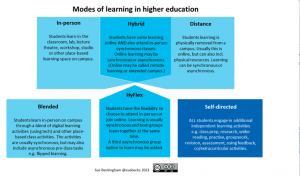 Last week I said that we were running a track on Personal Learning Environments at the TEEM conference. ON wednesday I received an email from the co-convener of the track, Linda Castaneda.
Last week I said that we were running a track on Personal Learning Environments at the TEEM conference. ON wednesday I received an email from the co-convener of the track, Linda Castaneda.
"We have to write a presentation paper with our thoughts for the PLE track in TEEMS before the 3rd of September (this is Friday next week).
I have imagined the following flow of work, and if you agree, it would be a great idea to start ASAP.
I think the challenge of our presentation paper is reshaping the PLE question and highlighting the importance of PLE in this world after the pandemia at any level AND fostering the debate and discussion around it… SO, I think it would be good to do a collection of ideas in a kind of list.
Please send me a list of 10(? As many as possible) ideas you consider are crucial to understanding the role/importance of PLE nowadays. Please develop your ideas…"
So here are my ten ideas - not as developed as I would like them to be but time is short.
1, Covid19: the turn to digital and PLEs.
There is a good argument that COVID 19 and the turn to digital should be bringing PLEs back into the foreground. With most education being delivered digitally the need for a Personal Learning Environment to bring together learning from different modes has never been greater. However, there is also some evidence that institutions under pressure of the rapid digital turn, have moved towards more standardised curricula and toward more tightly prescribed uses of software.
One unresolved issue is what extent learners had autonomy during this unprecedented extension of online learning. There is some evidence of tensions, for example as to whether students should be allowed to turn their cameras off during synchronous online video sessions. But probably an even greater unknown despite the volume of ongoing research is the level of informal learning and learning through social networks which happened during school lockdowns.
Furthermore, there is ongoing debate as to what the new school and university will look like. As might be expected there is intense discussion over nomenclature of different modes of learning now, and in the future. The diagramme above is one of the simpler ones.
The likely provision of different modes, and agency for students in choosing what mode to follow would seem support the idea of PLEs to bring together that learning from different modes including self-directed learning.
- Open education and PLEs
There would appear to be close links between the recent growth of research into Open Education and the idea of PLEs. PLEs present an approach to building on Open Educational Resources and Open Education in general.
- Personalised Learning and Personal Learning Environments
These quite simply are not the same thing, but they keep getting confused. Personalised Learning (more explicitly Personalised Adaptive Learning, based on Machine Learning and Arterial Intelligence. Personalised Adaptive Learning utilises Artificial Intelligence and Machine Learning in providing individual learning pathways for learners, based around their background, learning aims and learning performance. This might of course, contribute to a Personal Learning Environment. But the most popular Personalised Adaptive learning programme in the world at present, DuoLingo while presenting a gamified environment in which learning takes place, has few features of what we have in the past understood by PLEs.
4. Developing PLEs
In the past there has been a tendency to understand PLEs as a mash up of different software applications, especially drawing on the interactivity of Web 2.0 tools. A different and emerging way to look at PLEs is in terms of work flows and actions to be undertaken in order to develop a PLE based around a learner’s needs. For instance, students interviewed a spart on one study in these papers study reported that their ideal PLE would include opportunities for discussion, collaboration, and interaction; tools for organizing, planning, and resource management; experiential learning strategies; and the use of effective technology to support a personalized learning experience.
- Data and PLEs
Another trend accelerated by Covid 19 has been digitalisation. Most digital applications depend on increasing quantities of data. PLEs can also be based around data – learner’s data The importance of trustworthy data sources to feed a PLE is now more significant. It could also be useful for PLE tools to support some degree of argument mapping, to help separate arguments from supporting evidence.
One issue is that Learning Analytics offers great potential if data could be provided to students through a PLE to encourage and support reflection on learning and help with learner progression. However, the Learning Analytics community has largely focused on form education in universities and on data drawn from VLEs, rather than looking at wider domains for learning. Furthermore, the aim of many Learning Analytics applications are primarily to reduce drop out rates, rather than support earning processes.
- Digital Competence
There are further implications from the use of data in PLEs. One is the increasing importance of what si now being called digital competence. Indeed, it may be that lack of digital competence among learners (and among teachers) is a considerable barrier to developing PLEs. But it must be noted that the concept of digital competence is fluid including different definitions of what digital competence is but also probably changing rapidly as digitalisation continues.
- Artificial Intelligence and PLEs
I have already pointed to the confusion between PLEs and Personalised Adaptive Learning. But AI and machine learning could potentially enhance many areas of education, including PLEs. Applications have already been developed which can greatly speed up the development of Open Educational Resources. Those working and learning in transnational contexts, have free access to AI based translators such as DeepL. One area which could greatly enhance PLEs would be the development of AI based personal assistants, capable of supporting learners in developing their PLEs.
- Metacognition
Although in the past the importance of managing one’s own learning through a PLE was recognised, it was under appreciated how difficult this could be for many learners. The key to this is metacognition.
Metacognition is, put simply, thinking about one’s thinking. More precisely, it refers to the processes used to plan, monitor, and assess one’s understanding and performance. Metacognition includes a critical awareness of a) one’s thinking and learning and b) oneself as a thinker and learner.
Ultimately, metacognition requires students to “externalize mental events” (Bransford et al., 2000), such as what it means to learn, awareness of one’s strengths and weaknesses with specific skills or in a given learning context, plan what’s required to accomplish a specific learning goal or activity, identifying and correcting errors, and preparing ahead for learning processes.
- Ethics
The increasing use of big data in education and the rapidly advancing adoption of AI based applications, have led to an increasing concern over ethics. At present this tends to be linked to particular issue – for instance bias in AI based selection, the non-inclusiveness of online proctoring services and concern over surveillance by, for example, applications monitoring student attention and motivation.
There have been various calls for ethical frameworks and codes of practice. What may be more interesting is the idea of ethical practice (mirroring the recent attention to open educational practice). Ethical practice could extend beyond support, care and equity and support for metacognition to include working with learners in developing their Personal Learning Environment.
- Learner centred learning and learner control
Earlier research into Personal Learning Environments (see for example Ilona Buchem, Graham Attwell, Ricardo Torres, 2011) identified the issue of learner agency and learner control as central to the development of Personal Learning Environments. And despite a superficial profession of learner centered learning, it seems that in reality learners have only very limited control of their learning. Until this changes, the chance of widespread adoption of PLEs remains unlikely.








